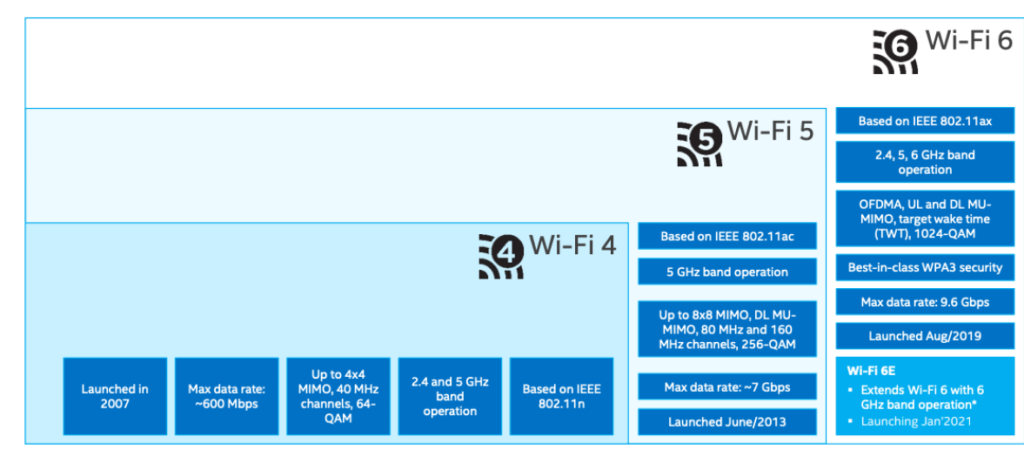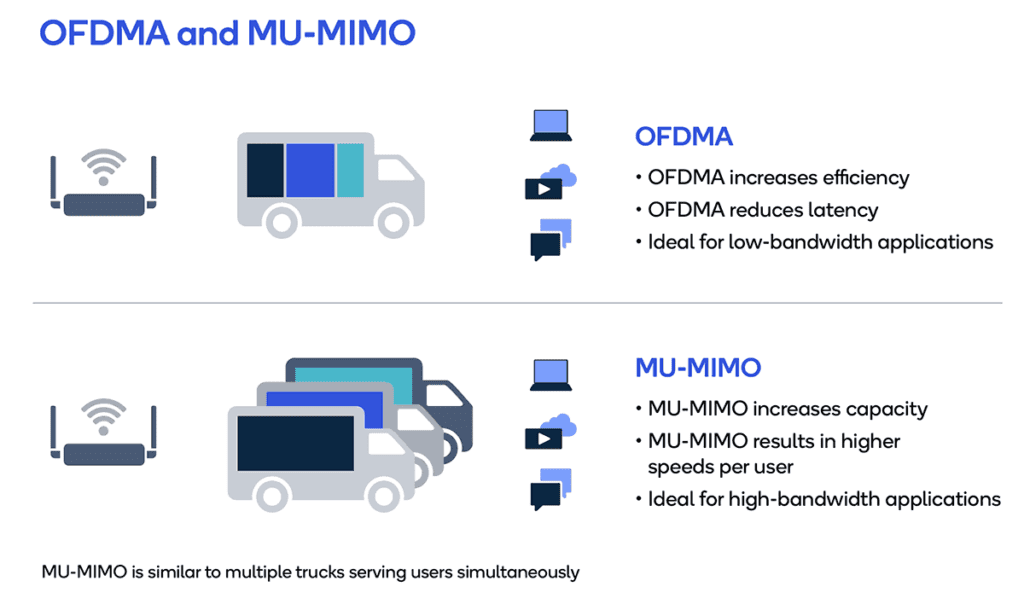802.11ac (more commonly known as Wi-Fi 5) is the fifth generation of wireless standard released in 2014 by the Wi-Fi Alliance. While it was a much-needed upgrade to the previous Wi-Fi 4 standard, it still had a number of issues.
802.11ax (more commonly known as Wi-Fi 6) was developed as a response to the growing number of connected devices on a network, namely Internet of Things (IoT) devices like smart lights or even appliances like a fridge or washing machine.
It’s important to note that Wi-Fi 6 didn’t re-imagine wireless routers. Instead, it introduced a series of incremental improvements to existing Wi-Fi standards that add up to a substantial upgrade over the older generation of Wi-Fi.
Let’s go through these changes one by one and address the primary question: What are the differences between 802.11ac (Wi-Fi 5) and 802.11ax (Wi-Fi 6)?
I will also discuss whether upgrading to Wi-Fi 6 is necessary and explain why using Wi-Fi 6 access points/routers may not necessarily make your internet faster.
What Needed to be Fixed in Wi-Fi 5?
First, let’s examine the issues associated with Wi-Fi 5 that Wi-Fi 6 aimed to address and improve upon.
Issue 1: Congestion
Wi-Fi 5 access points often face congestion in crowded public areas where numerous devices are connected to a single router.
The more devices competing for the same wireless signal in a small area – the worse the speeds and connectivity became.
However, the same issue can also occur in your home network. Think about it – if you have 10-15 devices connected to your Wi-Fi network, and so do all your neighbors to their Wi-Fi network, that adds up to a lot of wireless devices and Wi-Fi networks all fighting for the same bandwidth.
Issue 2: Range
Wi-Fi 5 access points using the 5GHz band had limited wireless signal coverage, with signals unable to penetrate obstacles (such as thick walls) and travel long distances.
Issue 3: Backwards compatibility
Backwards compatibility can be an issue because some devices that operate within the 2.4GHz band may not work well (or at all) on a 5GHz network. You may experience this issue for yourself when connecting a smart home device like a smart plug. Most of these devices will only be compatible with a 2.4GHz band network.
Issue 4: Security
Wi-Fi 5 only offers two security protocols known to have several serious vulnerabilities – WPA and WPA2.
Now, let’s get into what makes Wi-Fi 6 a better choice compared to Wi-Fi 5.
Wi-Fi 5 vs Wi-Fi 6 Differences
These two wireless protocols may sound similar, but when you take a closer look, they have some important differences.
Speed
Wi-Fi 5 promises a maximum data transfer speed of 6.9Gbps, but due to hardware limitations – you won’t actually see these speeds on individual devices. In most cases, 802.11ac (Wi-Fi 5) has an average data speed of about 200 Mbps.


The speed of a wireless standard relies on something called Quadrature Amplitude Modulation (QAM), and the number of devices using the router. Wi-Fi 5 utilizes 256-QAM modulation, which is lower than the one used by Wi-Fi 6.
In comparison, Wi-Fi 6 is a better choice in terms of speed, especially for congested wireless networks. It uses 1024-QAM modulation and a theoretical maximum speed of up to 9.6 Gbps.
The real speed improvements are noticeable when numerous devices are connected to a single Wi-Fi access point. Wi-Fi 6 ensures that even with a substantial number of connected devices, there will be minimal impact on the speed, which is one of the main improvements over Wi-Fi 5.
Frequency Bands
One noticeable distinction between Wi-Fi 5 and Wi-Fi 6 is in the frequencies used by each standard.
Wi-Fi 5 only operates on the 5Ghz band, which allows the Wi-Fi signal to be sent with less interference, meaning better speeds. However, it comes with a drawback: signals transmitted at this frequency have a shorter range and can’t easily go through walls or other physical obstacles.
Wi-Fi 6 uses two different band frequencies – 2.4Ghz and 5Ghz. Using both frequency bands allows connected devices to automatically scan and use the frequency band with minimal interference. As a result of this improvement, users will experience faster speeds when in close proximity to the router (using the 5GHz band), but also see a broader range but slower speed when devices are located further away (using the 2.4Ghz band).
There are also Tri-Band routers that provide one 2.4GHz and two 5Ghz Wi-Fi network bands.
MU-MIMO
Usually, Wi-Fi Routers communicate with each device one by one. Consequently, if several devices are connected to a single access point, it might create a queue, which slows down the speed for every device on that network.
MU-MIMO stands for “Multi-user, multiple-input, multiple-output”. This technology allows the router to “talk” to several devices on the same network simultaneously by assigning spatial streams to each antenna. It eliminates the queue and makes it possible for the router to respond to more connected devices faster. For each device, it reduces wait time, allowing the router to receive more data from more connected devices.
Here’s a different way to look at it. Instead of sending data to devices in “bursts” (also known as “packets”), MU-MIMO enabled routers send a steady stream of data to multiple devices on your network, without delay or pause.
You will also see the benefit of MU-MIMO technology during Wi-Fi-intensive activities that require high bandwidth such as gaming and 4K video streaming. This is because MU-MIMO uses separate channels to send and receive even more data.


OFDMA
The second piece of technology making Wi-Fi 6 faster is OFDMA. It stands for Orthogonal Frequency Division Multiple Access.
OFDMA is ideal for low-bandwidth applications because it can dedicate a single channel to one user at a time, or it can subdivide the same channel for multiple users – ideal for low bandwidth applications.
As you can see, these technologies complement each other to make the connection feel faster for both high-bandwidth and low-bandwidth applications.
Battery Life
Another feature of Wi-Fi 6 is Target Wake Time (TWT).
TWT allows devices to schedule specific times to wake up and communicate with the router. As a result, this feature allows devices to conserve more battery power when not actively sending or receiving traffic.
By optimizing the scheduling of network activity, Wi-Fi 6 can reduce the time devices need to stay awake and listen for signals, resulting in improved battery life.
It’s important to note that the impact of Wi-Fi 6 on the battery life is not significant for all devices on a network. For example, your computer needs to stay connected to Wi-Fi constantly, therefore, this device won’t make heavy use of this feature. But other battery-operated devices can save a significant amount of energy, like smart blinds or wireless sensors.
TWT is mainly used by low-powered Wi-Fi devices that need to send infrequent updates now and then. This includes smart-home and IoT devices and small sensors placed around your home.
Target Wake Time (TWT) is missing in Wi-Fi 5. As a result, power consumption is higher.
Beamforming
Another technology that was improved in Wi-Fi 6 is called Beamforming.
Instead of broadcasting wireless signals in all directions, Wi-Fi 6 uses a data transmission technique that makes the router detect where the device that requests the data is located and sends independent data streams in that direction. As a result, Beamforming improves Wi-Fi range and performance for devices connected to the router.


Security
Wi-Fi 5 ensures a secure connection by offering two security protocols WPA (Wi-Fi Protected Access) and WPA2. Today, these protocols are known to have several vulnerabilities. One of them is dictionary attacks, where cyber criminals try a large number of passwords from a pre-existing list to attempt to gain unauthorized access to a network.
Wi-Fi 6 fixes this vulnerability by using WPA3, which is essentially a more complex and secure version of WPA2. Wi-Fi routers supporting WPA3 implement a different handshake technology for wireless networks using Dragonfly Key Exchange, also referred to as SAE (Simultaneous Authentication of Equals).
Can You Take Advantage of Wi-Fi 6 Speeds?
Keep in mind that the connection between your device to your router and the router to your Internet Service Provider (ISP) are two different things.
Your Wi-Fi network may be capable of super-fast speeds of up to 1000Mbps for example, but if the internet plan you have with your ISP is only 100Mbps, you won’t notice much of a difference in everyday download/upload speeds (e.g. downloading a large file from the internet). This is also known as a “bottleneck”, where your internet plan is the one limiting your speed potential.
Instead, Wi-Fi 6 brings the most improvement to the local connection between your router and your devices, rather than the speed at which you can access the internet as a whole, which your ISP determines (e.g. your download and upload speeds).
The goal of Wi-Fi 6 is not necessarily higher download and upload speeds, but to maintain faster speeds for each device connected to the network, especially when numerous devices are connected. It introduces technologies that allow routers to communicate with more devices simultaneously, send traffic to multiple devices at once, and schedule check-ins with devices. These features help maintain strong connections even as the number of devices demanding data increases.
As a result, you’ll see the most significant speed improvements when connecting a large number of devices to your router, or sending a large amount of data wirelessly between devices (e.g. from a media server to a TV, or a computer to a Network Attached Storage device (known as a NAS).
Should You Upgrade to Wi-Fi 6?
To upgrade to Wi-Fi 6, you will need devices that support the Wi-Fi 6 wireless protocol. However, rushing out and buying new laptops and new phones is unnecessary, as improvements in Wi-Fi 6 are not considered groundbreaking.
Over the next few years, new phones, laptops, and other devices will be Wi-Fi 6 compatible, thus, making the transition seamless and easier.
The speed upgrade provided by Wi-Fi 6 will depend on the number of devices on your network and their data demands.
While individual device speeds may not change dramatically, the overall performance and reliability of the network are expected to improve in everyday usage scenarios, especially in networks with multiple devices.
Note that you will need a Wi-Fi 6 router to create a Wi-Fi 6 network in the first place.
Wi-Fi 5 vs Wi-Fi 6: The Bottom Line
Overall, while Wi-Fi 6 does bring several significant improvements over it’s Wi-Fi 5 predecessor, it’s unlikely to make a significant difference compared to your existing Wi-Fi network. You’ll need to ensure your ISP speeds are fast, and both your router and wireless devices can support Wi-Fi 6 to take advantage of most of the improvements.
For most people, this could cost a fair amount of money. It’s often better to simply wait until you own a number of Wi-Fi 6 devices (like a laptop) before upgrading your router to a Wi-Fi 6 compatible one.
In addition, Wi-Fi 6 has already been superseded by Wi-Fi 6E. If you want to learn more, you can read about the differences between Wi-Fi 6 vs Wi-Fi 6E.
Frequently Asked Questions
Is Wi-Fi 6 good for gaming?
Wi-Fi 6 is certainly a good choice for gaming due to several improvements over Wi-Fi 5.
Wi-Fi 6 reduces latency, which is the time it takes for data to travel between the original source and the destination.
Thanks to MU-MIMO, Wi-Fi 6 allows the router to “talk” to several devices on the same network simultaneously. It’s perfect for Wi-Fi-intensive activities such as gaming.
Is Wi-Fi 6 faster than Wi-Fi 5?
Wi-Fi 6 (802.11ax) introduces several advancements and improvements over Wi-Fi 5 (802.11ac) that contribute to increased speeds.
Wi-Fi 6 has a higher theoretical maximum speed of 9.6Gbps compared to 6.9Gbps in Wi-Fi 5.
Wi-Fi 6 introduces new technologies like OFDMA and MU-MIMO to improve speed and efficiency.
Wi-Fi 6 is generally faster for crowded environments, and has enhanced range and coverage.
Remember that you need to have Wi-Fi 6 compatible devices to enjoy these improvements.
Does Wi-Fi 6 have a better range?
Wi-Fi 6 has a better range than Wi-Fi 5 because it employs two different band frequencies – 2.4Ghz and 5Ghz.
Using both frequency bands allows connected devices to automatically scan and use the frequency band with minimal interference. As a result, you get faster speed when in close proximity to the router and a broader range when your devices are located far away.
In addition, improved beamforming technology in Wifi-6 improves Wi-Fi range and performance.
Does Wi-Fi 6 work with Wi-Fi 5?
Wi-Fi 6 routers are fully compatible with Wi-Fi 5 and previous-generation Wi-Fi devices.





